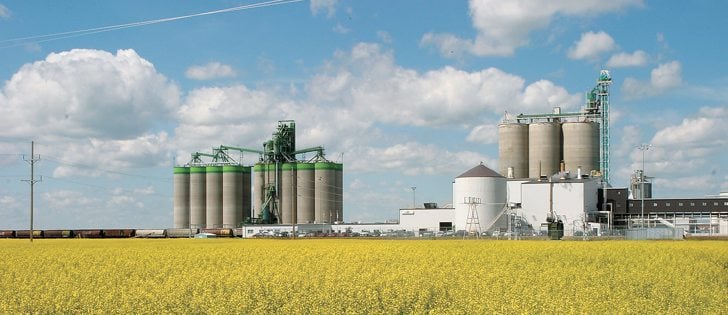After his first year at the University of Calgary’s veterinary school, Layne Manson can make incisions, stitch them up and properly roll over a sheep in need of treatment.
The native of Bonnyville, Alta., helped deliver twin calves earlier this year and learned how to tie proper knots when restraining animals.
He is one of 30 students at the new school, which opened last September, and realizes many of the hands-on skills he has gained in two semesters would not be the normal experience for many first year students.
Read Also

VIDEO: Case IH reveals new Optum tractor at Agritechnica 2025
Case IH reveals its new Optum tractor at Agritechnica 2025.
“There is a lot less class time than I expected, but a lot more hands on,” said Manson, who has an animal science degree from the University of Alberta.
He plans to go into a mixed rural practice after he graduates in 2012 and appreciates the hands-on work, as well as the chance to work with Alberta veterinarians in their clinics during his final year of study.
He is among the first to use the newly opened clinical skills facility at the university’s off-site campus in northwestern Calgary.
The facility houses state of the art diagnostic laboratories, anatomy facilities, pathology areas, animal waste treatment and live animal studies where students work with sheep, hogs, cattle, horses, reindeer and some small animals.
The modern equipment allows students to learn how to use the latest diagnosis technology.
Smart boards that share images from dissection tables with an entire classroom are not always available in older schools.
Planning stages
The Calgary veterinary school was just an idea in 2004 as the province struggled with BSE, closed borders and a shortage of diagnostic laboratories and rural vets.
Alberta advanced education minister Doug Horner said the answer was to build the first new vet school in Canada in more than two decades. It is Canada’s fifth accredited veterinary school.
“During the time of BSE, labs, veterinary medicine and the science of zoonosis was the top of mind for all Albertans,” said Horner, who was agriculture minister during part of the BSE crisis.
The province invested $80 million to build the 80,000 sq. foot clinical skills facility, a wildlife study area and other upgrades at the university medical school where the students receive classroom training.
The school emphasizes large animal practice and is also available for continuing education programs and pathology labs for practising veterinarians.
MOOSE JAW, Sask. – There is enough sweeping going on at the Western Canadian Classic junior dairy show to make one wonder: do these youths work this hard to keep their rooms clean at home?
A tidy and decorated stall area is a must. The 100 competitors aged 12 to 21 know they are being judged on that, as well as their friendliness, knowledge and performance in the show ring. But they don’t know who the judges are.
As visitors wander through the areas housing each of the four western provinces, busy 4-H members take time to greet them and smile.
The event celebrated 25 years last week in Moose Jaw, Sask. The competitors chose decorations that illustrated the history of the show that began in Saskatoon in 1985.
Neil Crosbie of the 2009 organizing committee said the show, when held in Saskatchewan, is usually in Regina or Saskatoon. But escalating costs led them to Moose Jaw’s Golden Mile Arena for the silver anniversary.
This is the first time the show has been in Moose Jaw and the first dairy show in the city in decades. It was modeled after a similar event in Eastern Canada, said Crosbie.
“Ten founding members got together and said, ‘Why not have one in Western Canada?’” he said.
The event has grown and changed over the years.
Emma Robinson, a 21-year-old from Steinbach, Man., was competing in her last show and worries about the future. In Manitoba, just one 4-H club focuses on dairy now; there used to be five.
“It’s a struggle,” she said. “A lot of the younger ones are not on the farm anymore.”
Crosbie agreed. There are fewer dairies, as well. Saskatchewan, for example, has just 198 left.
“It’s getting harder and harder all the time,” he said.
Saskatchewan and Manitoba send teams of 20 to the WCC, while Alberta and British Columbia send 30 to reflect more dairies and more youth in 4-H.
Alberta’s Katelyn Crest of Athabasca went home the big winner after showing the grand champion heifer, Alfalfa. The 14-year-old also won the junior judging event and the summer yearling competition, and placed second in the dairy science quiz behind Michael Luttmerding of Armstrong, B.C.
Chad Crest, 17, was named grand champion showman and placed second in intermediate judging behind Erin Loogman of Westlock, Alta.
Danielle Saelman from Chilliwack, B.C., won the intermediate quiz competition.
In senior events, Lee Simanton of Ponoka, Alta., won the judging and dairy quiz titles. Nicole Hylkema of Chilliwack won senior showmanship and was named reserve grand champion showman.
Clipping event winners were: Lee Morey of Rochester, Alta., junior; Chad Crest, intermediate; and Simanton, senior.
Conformation class winners were: Keith Kozak of New Sarepta, Alta., junior calf; Katelyn Kozak, intermediate calf; Ian Crosbie of Caron, Sask., senior calf. Crosbie also showed the reserve grand champion heifer.
Edith Wouters of Innisfail, Alta., had the top junior yearling, while Rebeka Hunter of Ferintosh, Alta., won intermediate yearling and Kenton Lindenbach of Balgonie, Sask., showed the top senior yearling.
Alberta won the overall competition, followed by B.C., Saskatchewan and Manitoba.















